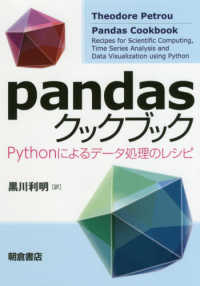- ホーム
- > 洋書
- > 英文書
- > Business / Economics
基本説明
Case studies of big-name employer brand stories include Tesco, Wal-Mart, British Airways and Prêt a Manger.
Full Description
Levels of 'employer brand awareness' are rising fast across Europe, North America and Asia-Pacific, as leading companies realise that skilled, motivated employees are as vital to their commercial success as profitable customers and apply the principles of branding to their own organization. Starting with a review of the pressures which have generated current interest in employer branding, this definitive book goes on to look at the historical roots of brand management and the practical steps necessary to achieve employer brand management success - including the business case, research, positioning, implementation, management and measurement. Case studies of big-name employer brand stories include Tesco, Wal-Mart, British Airways and Prêt a Manger.
Contents
List of Illustrations xi
Acknowledgements xiii
Preface xv
Part I: The Rationale for Change 1
1 Birth of an Idea 3
2 The Changing Needs and Aspirations of Employees 13
3 Investors Awaken 21
4 The People Management Challenge 37
5 The Role of Leadership 45
Part II: The 'How To' Guide 55
6 Brand Fundamentals 57
Functional Benefits 58
Emotional Benefits 58
Higher Order Benefits, Brand Values and DNA 59
Brand Personality 60
Brand Positioning and Differentiation 61
Brand Hierarchy 63
Brand Vision and Brand Reality 64
Brand Management and Development 65
Brand Consistency and Continuity 65
Brand Development 67
Summary 68
7 The Business Case 69
The Major Benefits of Employer Branding 69
Lower Costs 69
Customer Satisfaction 71
Financial Results 72
Summary 74
Life Cycle Benefits 74
Young, Fast Growing Companies: Attracting 'The Right Stuff' 74
Coming of Age: Capturing the Organisational Spirit 75
Going International: Translating the Employer Brand into New Contexts 75
Merger and Acquisition: Forging a Shared Sense of Identity and Purpose 76
Corporate Reinvention: Refreshing the Self-Image 77
Revitalizing the Customer Brand Proposition: Living the Brand 77
Burning Platform: Re-instilling Fresh Belief 78
Functional Benefits 78
Benefits to the HR Function 78
Benefits to the Internal Communications Function 79
Benefits to the Marketing Function 80
Winning Support from the Top 81
Summary 83
8 Employer Brand Insight 85
Employee Insights 86
Employee Engagement and Commitment 88
Benchmarking 89
Correlation Analysis 91
Continuous Research 92
Culture Mapping 93
Brand Roots 95
Projective and Enabling Techniques 96
Observation 99
Segmentation 100
Communication Audits 102
Additional Sources 103
Labour Market Insights 104
Clarifying the Target Market 104
Needs and Aspirations 105
Employer Brand Image 106
Summary 108
9 Employer Brand Positioning 109
Brand Identity 109
Monolithic 109
Parent 110
Subsidiary 110
Brand Integration (Customer and Employer Brands) 110
Corporate Brand Hierarchy (Parent and Subsidiary) 111
The Key Components of the Positioning Model 113
The Brand Reality Model 113
The Brand Vision Model 116
Target Employee Profiles 116
The Employer Brand Proposition 117
Values 119
Personality 122
Benefits 123
Employee Value Propositions 125
Reasons to believe 126
Summary 126
10 Employer Brand Communication 129
Identity 129
Internal Launch 130
Rational Understanding 132
Emotional Engagement 135
Employee Commitment and Behaviour Change 141
Summary 144
11 Employer Brand Management 147
Big Picture: Policy 149
External Reputation 149
Internal Communication 151
Senior Leadership 152
Values and Corporate Social Responsibility 152
Internal Measurement Systems 154
Service Support 154
Local Picture: Practice 155
Recruitment and Induction 155
Team Management 156
Performance Appraisal 157
Learning and Development 157
Reward and Recognition 159
Working Environment 159
The Key Responsibilities of Employer Brand Management 160
Summary 161
12 The Durability of the Employer Brand Concept 163
Part III: Appendices 165
Appendix 1: Reuters Case Study 167
Appendix 2: Tesco Case Study 185
Appendix 3: Extract from Greggs Development Review 197
References 201
Index 207








